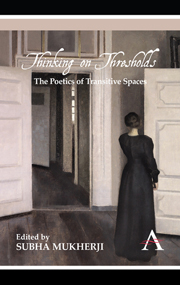Book contents
- Frontmatter
- ACKNOWLEDGEMENTS
- Contents
- List of Illustrations
- Notes on Contributors
- Introduction
- Part One Doors, Windows, Entries
- Part Two Lives and Narratives, Territories and Worlds
- 5 Unsettling Thresholds: Mignon and Her Afterlives
- 6 Dangerous Liaisons: Desire and Limit in The Home and the World
- 7 Writing Through Osmotic Borders: Boundaries, Liminality and Language in Mehmet Yashin's Poetics
- 8 Dancing and Romancing: The Obstacle of the Beach and the Threshold of the Past
- Part Three Matter, Mind, Psyche
- Part Four Reading, Writing, Playing, Listening
- Select Bibliography (including Discography)
5 - Unsettling Thresholds: Mignon and Her Afterlives
from Part Two - Lives and Narratives, Territories and Worlds
Published online by Cambridge University Press: 05 March 2012
- Frontmatter
- ACKNOWLEDGEMENTS
- Contents
- List of Illustrations
- Notes on Contributors
- Introduction
- Part One Doors, Windows, Entries
- Part Two Lives and Narratives, Territories and Worlds
- 5 Unsettling Thresholds: Mignon and Her Afterlives
- 6 Dangerous Liaisons: Desire and Limit in The Home and the World
- 7 Writing Through Osmotic Borders: Boundaries, Liminality and Language in Mehmet Yashin's Poetics
- 8 Dancing and Romancing: The Obstacle of the Beach and the Threshold of the Past
- Part Three Matter, Mind, Psyche
- Part Four Reading, Writing, Playing, Listening
- Select Bibliography (including Discography)
Summary
The opening of the third book of Goethe's Wilhelm Meisters Lehrjahre (Wilhelm Meister's Apprenticeship Years) is one of the most arresting moments in the history of the novel. Without explanation, without context, the reader encounters a lyric poem in three stanzas, and readers of the first edition in 1795 found opposite it, on a fold-out page, a musical score that provides a setting for the poem. After the text of the song comes the context. Wilhelm is in his room when he hears someone playing a musical instrument outside his door, on the threshold. At first he thinks it is the Harpist, who had been playing and singing outside his door the previous evening. But when he hears the singer's voice, he realises it is Mignon. He opens the door, she crosses the threshold and sings the song that becomes her signature tune and one of Goethe's best-known poems: ‘Kennst du das Land?’ (‘Do you know the land?’).
The positioning of Mignon and her song on the threshold both of the printed text (the third book begins the second separate volume in the first edition) and of the fictional scene is hardly an accident. Mignon will remain on the margins of Wilhelm's life and and of his angle of perception throughout the novel. In one of its most fraught episodes, when Wilhelm and the company of actors he has assembled around him have been celebrating their successful performance of Hamlet, Mignon plans to enter his bedroom, but from the stairs, outside his door, she sees Philine go in and close the door behind her.
- Type
- Chapter
- Information
- Thinking on ThresholdsThe Poetics of Transitive Spaces, pp. 73 - 86Publisher: Anthem PressPrint publication year: 2011



